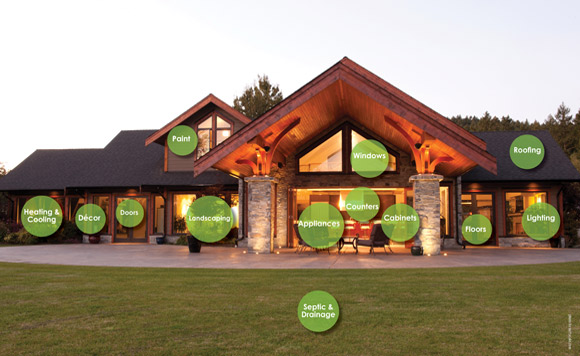The latest trends, processes and materials you need to know about and how to make your home an energy and money saving machine.
Interior Ideas
Cabinets – To “go green” when renovating or creating a new kitchen, cabinets can be manufactured with panel material made from recycled Canadian wheat stalks. Coatings that are free of Hazardous Air Pollutants or allergy sensitive are also available. Natural timber for cabinets should be sourced from Forest Stewardship Council certified vendors. “Greenguard” certified materials and recycled aluminum extrusions with no Volatile Organic Compounds take your eco-friendly kitchen even further. Work with designers who conform to Leadership in Energy and Environmental Design (LEED).
courtesy www.cabinetworksvictoria.com
Lighting – Save on electricity and money when you change over to LED bulbs, great for indoors and out. LED bulbs are a more expensive replacement than conventional incandescent bulbs initially, but their cost savings over just a short period of time will pay off.
courtesy www.illuminationsbc.com
Décor – Upcycling is a new term for repurposing. It’s the act of taking something no longer in use and giving it a second life and new function. In doing so, the finished product often becomes more practical and beautiful than what it previously was. An old console becomes a new vanity base; just drop in the sink. Pallet wood? Limitless uses! An old door = new coffee table. Paint gives just about everything new life. You are only limited by your imagination and a little elbow grease!
courtesy www.remarkableredesignstaging.com
courtesy www.interiorstylesbystacey.com
Heating & Cooling – Heat pumps are by no means a new invention and have been heating and cooling businesses and homes for many years, but they have gained popularity in recent years due to rising energy costs. With the potential to reduce energy bills by up to 50%, increase home comfort levels and shrink your carbon footprint, heating and cooling your home with a heat pump is THE green choice. courtesy www.uptownac.ca
Counters – Eco, by Cosentino, is a desired countertop product among friendly-planet concious builders and designers. It looks like quartz, but is made from recycled glass, mirror, ceramic tiles, stone chips, porcelain and crystallized ash. This has many benefits: fewer CO2 emissions produced; material previously destined for the landfill is given a new application; and fewer raw materials are extracted from the Earth.
courtesy www.stonetrends.ca
Flooring – Recycled flooring is a great option when “going green.” Locally, wood is salvaged from glue-laminated beams sourced from building demolition in B.C. This Douglas fir is sawn into rough lumber, kiln-dried, and then profiled into tongue and groove flooring. Old floor joists are also transformed into flooring. One recent source of this material has been the demolished North Saanich Middle School. Green options for floor finishes include natural oil coatings and water-based finishes.
courtesy www.westwindhardwood.com
Appliances – Today’s dishwashers are more environmentally friendly than ever. Not only do they save energy, but they save water as well. Some eco-friendly models use as little as six litres of water – half as much as the average, by maximizing water efficiency in the rinse cycles and recycling water that’s clean enough to use again. With water consumption at an all-time high, water-efficient dishwashers help us conserve one of B.C.’s most precious resources.
courtesy www.trailappliances.com
Eco-Friendly Exteriors
Landscaping – Using the micro-climates created by your house is an excellent way to diversify the way we grow food on the West Coast. A warm western wall could be home to a delicious peach tree; a trellis over a window could grow a grape or hardy kiwi. Using these vertical spaces and micro-climates provides dynamic and beautiful growing space right outside your door. Make your home an edible oasis! courtesy www.hatchetnseed.ca
Septic & Drainage – With all the new technology promoting “green” building options, homeowners need look no further than the soil in their backyard. When an onsite sewage system (septic system) is designed and operated according to B.C. standards, this soil can purify sewage by removing more than 99.99% of harmful bacteria and viruses. An on-site sewage system is essentially a waste water recycling system, ensuring that domestic waste water is clean and ready to re-enter the natural water cycle. With thanks to Payne Engineering and Geology: 250.655.3604 payneengineering@shaw.ca.
courtesy www.newaterseptic.ca
Windows – Three Affordable Ways to Improve the Energy Efficiency of Old Windows: Before replacing old windows and thereby making one of the most energy expensive upgrades you can make, improve the performance of your existing windows by considering storm windows, window films and exterior roller shades.
courtesy www.greenbuildingadvisor.com
Doors – To ensure your doors are “eco-friendly,” use a company whose suppliers get their wood from mills that operate responsibly harvested forests. The Forest Stewardship Council stamp means that forests around the world are being properly managed and tagged to stop illegal logging and deforestation. Buy doors made using non-toxic and solvent free wood glue. Door glass can be treated with a coating that stops harmful UV rays and increases the insulating value to save on heating costs. Many wood finishes are now waterborne.
courtesy www.calibredoors.ca
Paint – To help simplify some of the confusing definitions of what a “green paint” means, Benjamin Moore’s “Green Promise” designation is an assurance that its environmentally friendly paints and stains meet – and even exceed – the strictest industry standards while maintaining the premium level of performance you expect. Benjamin Moore’s waterborne tinting ensures that paints retain their low- or no-VOC properties even after tinting in any one of thousands of colours.
courtesy www.pacificpaint.benmoorepaints.com
Roofing – The predominant product in today’s roofing market is fibreglass/asphalt-laminated shingles. They represent 80% of the product used in the residential roofing market today. There are a number of rubber/polymer composite and metal products available that come with extended warranty periods and custom appearances. These are generally considered specialty products, and that’s reflected in the price. If the homeowner plans on staying in their home for many years and have a particular look they are wanting these products can be a good option.
courtesy www.admiralsroofing.com




